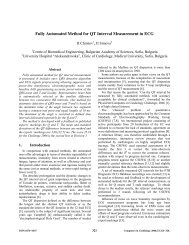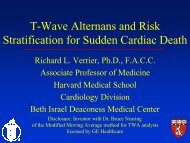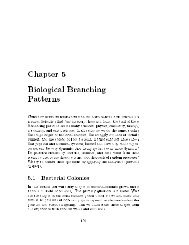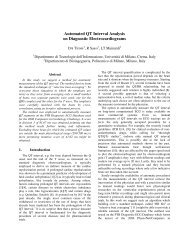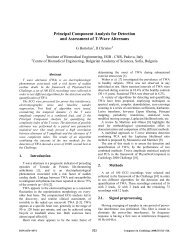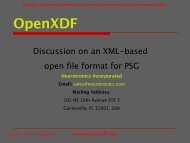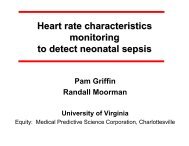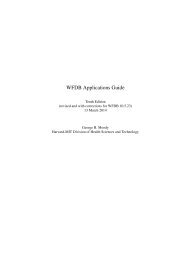An Improved Spectral Method of Detecting and Quantifying T-Wave ...
An Improved Spectral Method of Detecting and Quantifying T-Wave ...
An Improved Spectral Method of Detecting and Quantifying T-Wave ...
You also want an ePaper? Increase the reach of your titles
YUMPU automatically turns print PDFs into web optimized ePapers that Google loves.
3. Results<br />
For developing data sets (MIT/BIH Sudden Cardiac<br />
Death Holter Database <strong>and</strong> our normal subject database),<br />
our improved spectral method successfully indicates<br />
82.4% <strong>of</strong> people within SCD database at high risk, <strong>and</strong><br />
76.7% <strong>of</strong> people within normal database at low risk. The<br />
details <strong>of</strong> our results are listed in table 1.<br />
Table 1. The accuracy table <strong>of</strong> developing data.<br />
SCD database<br />
(17 records)<br />
AR<br />
(TH=2.5)<br />
EAR<br />
(TH=2.5)<br />
RI (dB)<br />
(TH=24)<br />
S: SVD<br />
(TH=5)<br />
# <strong>of</strong><br />
exception<br />
Accuracy<br />
Normal database<br />
(30 records)<br />
# <strong>of</strong><br />
exception<br />
Accuracy<br />
9 47.1% 8 73.3%<br />
5 70.6% 9 70%<br />
4 76.5% 9 70%<br />
3 82.4% 7 76.7%<br />
For testing data set (PCCC2008 with 100 samples),<br />
our proposed methods got the score <strong>of</strong> final reference<br />
ranking, 0.636 [14]. However, score 0.549 is achieved<br />
when only ERA method was applied. Table 2 lists<br />
st<strong>and</strong>ard statistic results <strong>of</strong> EAR <strong>and</strong> RI for both SCD <strong>and</strong><br />
PCCC2008 databases. The t-test probability <strong>of</strong> SCD<br />
database is not calculated because the sample size is less<br />
than 30 samples.<br />
Table 2. The st<strong>and</strong>ard statistics analysis <strong>of</strong> ERA <strong>and</strong> RI<br />
Mean±Std. Max Min t-test Prob.<br />
EAR<br />
(SCD)<br />
EAR<br />
(PCCC 2008)<br />
RI (dB)<br />
(SCD)<br />
RI<br />
(PCCC 2008)<br />
4.99±6.55 25.60 -1.41 n/a<br />
27.01±107.90 900.89 -1.60 < .0001<br />
34.92±12.29 62.72 21.45 n/a<br />
32.52±15.33 63.27 7.67 0.0139<br />
4. Discussion <strong>and</strong> conclusions<br />
The traditional AR is considered as our st<strong>and</strong>ard result. It<br />
is interested to compare our parameters (EAR/RI/SVD)<br />
with traditional AR values. Hence, based on the<br />
PCCC2008 database, the correlation coefficients were<br />
calculated in Table 3. We found that EAR <strong>and</strong> SVD<br />
values is somewhat correlated with AR values, but RI has<br />
low correlation.<br />
Table 3. Correlation coefficient matrix for traditional AR comparison<br />
EAR RI SVD<br />
AR 0.6629 0.3345 0.6656<br />
Overall, according to our results by analyzing<br />
SCD <strong>and</strong> PCCC2008 databases, the traditional TWA<br />
method still has the room to improve. In addition, our<br />
method is potentially able to estimate the levels <strong>of</strong> the<br />
SCD risk.<br />
Acknowledgements<br />
This work was supported in part by the Taiwan<br />
National Science Council under Grant NSC-94-2218-E-<br />
320.<br />
References<br />
[1] Hering HE. Das Wesen des Herzalternans. Münchener med<br />
Wochenshr. 1908;4:1417-21.<br />
[2] Richter S, Duray G, Hohnloser SH. How to analyze T-<br />
wave alternans. Heart Rhythm. 2005;11:1268-71.<br />
[3] Pham Q, Quan KJ, Rosenbaum DS. T-<strong>Wave</strong> Alternans:<br />
Marker, Mechanism, <strong>and</strong> <strong>Method</strong>ology for Predicting<br />
Sudden Cardiac Death. Journal <strong>of</strong> Electrocardiology.<br />
2003;36(Suppl):75-81.<br />
[4] Janusek D, Pawlowski Z, Maniewski R. Evaluation <strong>of</strong> the<br />
T-wave alternans detection methods: a simulation study.<br />
<strong>An</strong>adolu Kardiyol Derg. 2007 Jul;7 Suppl 1:116-9.<br />
[5] Armoundas AA, Tomaselli GF, Esperer HD.<br />
Pathophysiological basis <strong>and</strong> clinical application <strong>of</strong> T-<br />
wave alternans. Journal <strong>of</strong> the American College <strong>of</strong><br />
Cardiology. 2002 Jul 17;40(2):207-17.<br />
[6] Martinez JP, Olmos S. <strong>Method</strong>ological principles <strong>of</strong> T<br />
wave alternans analysis: a unified framework. IEEE<br />
transactions on bio-medical engineering. 2005<br />
Apr;52(4):599-613.<br />
[7] Rosenbaum DS, Jackson LE, Smith JM, Garan H, Ruskin<br />
JN, Cohen RJ. Electrical alternans <strong>and</strong> vulnerability to<br />
ventricular arrhythmias. The New Engl<strong>and</strong> journal <strong>of</strong><br />
medicine. 1994 Jan 27;330(4):235-41.<br />
[8] Smith WM. Cardiac defibrillation. Engineering in<br />
Medicine <strong>and</strong> Biology Society, IEEE 17th <strong>An</strong>nual<br />
Conference. 1995 20-25 Sep;1:249 - 50.<br />
[9] Moreno-Martinez E, Amo-Lopez P, Cruz-Roldan F,<br />
Blanco-Velasco M. Enhanced <strong>Spectral</strong> <strong>Method</strong> for T-<strong>Wave</strong><br />
Alternans analysis. Intelligent Signal Processing, 2007<br />
WISP 2007 IEEE International Symposium on. 2007 3-5<br />
Oct.:1-6.<br />
[10] Strumillo P, Ruta J. Poincare mapping for detecting<br />
abnormal dynamics <strong>of</strong> cardiac repolarization. IEEE Eng<br />
Med Biol Mag. 2002 Jan-Feb;21(1):62-5.<br />
[11] Pan J, Tompkins WJ. A real-time QRS detection<br />
algorithm. IEEE transactions on bio-medical engineering.<br />
1985 Mar;32(3):230-6.<br />
[12] Kamath C, <strong>An</strong>anthapadmanabha TV. Modeling QRS<br />
complex in dECG. IEEE transactions on bio-medical<br />
engineering. 2007 Jan;54(1):156-8.<br />
[13] Haykin S. Neural Networks: A Comprehensive Foundation.<br />
2 ed: Prentice Hall 1999.<br />
[14] Abdi H. The Kendall Rank Correlation Coefficient. CA:<br />
Thous<strong>and</strong> Oaks 2007..<br />
Address for correspondence:<br />
Tsu-Wang Shen, Ph.D.<br />
Department <strong>of</strong> Medical Informatics<br />
Tzu-Chi University<br />
701, Sec. 3, Jhongyang Rd., Hualien, 97004, Taiwan<br />
tshen@mail.tcu.edu.tw<br />
612




